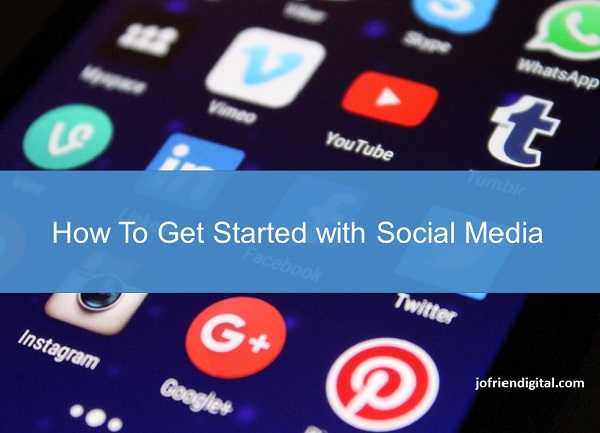Telephone: 01749 685251
Social Media – How to Get Started
Are you struggling to get started with social media for your business?
Social media can be overwhelming. If you’re short of time and resources, you want to get the best possible results for your efforts.
Here’s some tips for getting started…
Know your ‘why’
BEFORE getting started with social media, decide what you want to achieve for your business.
• Are you looking to get more customers?
• Do you want more people to know about your products and services?
• Is improving customer service important to you?
• Do you want to build relationships with your customers and contacts on social media?
• Do you want to send traffic to your website or blog?
What you do on social media will depend on your goals. Without a clear direction, you’ll end up wasting time on things which don’t get you where you want to go.
Know who you want to reach on social media
With around 42 million social media users in the UK and more than 2 billion globally – social media is a fabulous opportunity to let people know about your business.
BUT… to get the best results, you need to focus your efforts on the people who are most likely to benefit your business.
A lot of business owners really hate the idea of focusing on a particular group of people. However, it’s really important to help you identify…
• which social media sites to be on – there’s no point in creating great content for Facebook if your audience is on Twitter
• the type of content to share – your content needs to be interesting/relevant/useful for your audience, that means you need to understand who they are and the type of content that they’re likely to like, share or comment on
• who to follow and engage with – it’s not enough to show up and expect the right people to find you, you need to be actively finding, following and engaging with them
If you’re a small business, you might want to reach previous and current customers, prospective customers, companies you work with or businesses and organisations that deal with the same type of people you do.
Know your business personality
What’s your business personality? Do you want to be chatty and informal? Fun? Professional and authoritative? Slightly quirky and off beat?
Decide how you want to come across and make sure your style is consistent across all your social media, as well as the rest of your marketing.
Your personality will also have an impact on which social media sites are likely to be best for your business.
Chatty and informal? Try Facebook or Twitter.
Professional and authoritative? Consider LinkedIn.
Be realistic about the time you have available
There’s no getting around the fact that social media takes time. Most small businesses won’t want to spend hours each day updating their social media profiles.
Decide how much time you can spend, and stick to it. If you have time to manage more than one channel, great. However, you’re better off posting to one or two channels, regularly, than to three or four channels once in a blue moon.
Check out time-saving social media tools such as Buffer or Hootsuite which let you schedule posts in advance across the major social media sites.
Which social media networks are best for your business?
When choosing a social media network, there’s no one size fits all. The best site for you will depend on your business goals, audience and personality.
Whilst there are hundreds of different social media sites, here’s a quick overview of some of the most popular.
With around 1.5 billion users globally and 31 million in the UK, Facebook is still the biggest social media site by far. You can pretty much guarantee that some of your customers will be there.
Facebook has a very personal, chatty style and is potentially great for businesses dealing directly with consumers. Facebook is less good for companies with a more formal professional style.
It’s becoming more and more difficult to be effective on Facebook without advertising. If you want to get the best results, be prepared to pay.
Twitter has around 650 million global users and 15 million in the UK. It has a slightly younger demographic than Facebook, with most users under 50.
Whether you deal with other businesses or direct with consumers, Twitter can work well. The site has an informal style, but is also used by people looking for business news and insights so can be great for businesses looking to share professionally focused content.
One of Twitter’s unique characteristics has previously been the 140 character limit on posts. With around 250m tweets posted per minute, regular posting is essential to be seen.
Twitter can be great for building up visibility quickly, as well as sharing links to websites and blog content.
With around 400 million global users and 19 million in the UK, LinkedIn is THE channel if you’re selling products or services to other businesses.
With its’ professional focus, LinkedIn has a more formal style than other networks. It’s also the only social media site where over 30s outstrip younger users.
LinkedIn isn’t the best place for consumer-focused businesses to engage with potential customers. However, if you’re looking for small business tips, or to build relationships with complementary businesses, it may still be worth a look.
Pinterest is relatively new in social media terms but has rapidly grown to a global user base of around 47.1 million. There are around 10.3 million users in the UK.
Beautiful images are a must if you want to get anywhere on Pinterest. Currently, there are considerably more women than men on the site, although this is changing slowly.
Stats suggest that Pinterest users love shopping, so it’s got great potential if you’re selling online. Food, Fashion, Design and DIY are popular categories.
Instagram has only been around since 2010 but has already racked up around 400 million users, with around 14 million in the UK.
Instagram is a photo sharing app that’s all about relevant, creative and engaging visuals. Currently, around 70% of users are under 25 so it’s not right for every business.
One big difference between Instagram and other channels is that you can’t include clickable links in your Instagram posts. If you want to get traffic to your website, it may not be the best site for you.
If you can take great pictures, or if you’re in photography, food, fashion or travel, then Instagram may be worth a look.


Sorry, comments are closed for this post.